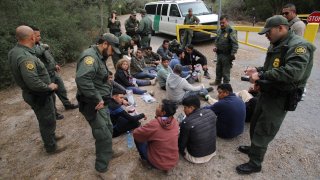“It’s Just Business:” Forced Migration through the Darién Gap
Nobody believes that the current Central American migration framework is a sustainable answer to the challenges that mass displacement poses.
Each and every day, Venezuelans fleeing poverty and oppression gather in small groups to begin a long, arduous trek northward toward freedom and a better life. It’s a dangerous and demanding journey, but their desperation keeps them going.
Along the way, they’ll be joined by refugees and migrants from Haiti, China, Afghanistan, and thirty or so other countries. Many of them—approximately 238,000 since the start of this year—will try to navigate the Darién Jungle (or Gap) as part of that journey. The Darién straddles the Colombia-Panama border and is one of the most treacherous stretches of jungle in the world.
When I recently traveled to Panama and Costa Rica—two key partners in our response to the forced displacement crisis—I got a small taste of just how demanding this journey can be for these families. But I also saw how, for many of them who’ve escaped their homeland with little money and few possessions, it will also be expensive—very expensive.
What I took away from the trip and my conversations there is that if we are ever going to tackle the tragedy of forced migration in the Americas, we must confront what these families are forced to pay and who is taking their money.
Forced displacement in the region is a business, big business. In order to navigate the Darién, smugglers and human traffickers will demand that migrants and refugees pay fees of $300 or more apiece—including for infants and young children. Traffickers lure the families with promises of a smooth, swift journey. In reality, the four-to-seven-day trek will bring them through terribly difficult terrain and make them vulnerable to crimes like robbery and assault anywhere along the way.
If and when they make it through the rainforest, they’ll be met by villagers who will give them seats—for $10 apiece—on wooden canoes that will carry them upriver to a temporary reception center (known as an ETRM) like the one I visited in Panama’s Lajas Blancas. To keep things moving, once the canoes move out, villagers call ahead to the ETRM so they know how many canoes and travelers are coming. At the center, officials register the migrants and refugees, offer medical care, provide access to food and water, and give them a place to sleep for a night or so.
From the ETRM, the travelers must pay $60 apiece (a jump from $40 just last year) to safely ride across Panama on privately-owned buses to reach their next stop, another humanitarian center near the border with Costa Rica. After a brief respite, they’ll board a new set of privately owned buses—at $30 per seat—to cross Costa Rica to humanitarian facilities near the border with Nicaragua. There, Nicaraguan officials will demand each migrant pay approximately $150 in order to enter that country and carry on their journey.
In other words, as they move from South to Central America towards the United States, migrants and refugees from Venezuela, China, Afghanistan, and elsewhere make payments to villagers, bus owners, criminal gangs, and the regime of Nicaraguan dictator Daniel Ortega. Some of the amounts are modest, like the $10 canoe ride, but others are not, and they lead to huge profits for nefarious actors. After all, according to Panamanian authorities, well over 900,000 people passed through the Darién region from 2021 to 2023.
Why are governments like Panama and Costa Rica willing to host humanitarian centers and permit the villagers and bus owners to participate in the migration process? Helping migrants and refugees access humanitarian assistance is a moral imperative for these two close American partners. Having migrants and refugees interact with officials minimizes the role of gangs and other bad actors in their countries. Bringing travelers through the centers helps officials identify infectious diseases and other risks.
But nobody believes that the current framework is a sustainable answer to the challenges that mass displacement poses. Nor does it make migration risk-free for the region. In just recent weeks, officials have intercepted individuals linked to terrorist organizations in Africa, the Middle East, and Asia.
Some of the answers are obvious: we have to confront regimes in Nicaragua, Cuba, Venezuela, and elsewhere that treat their people so brutally that everyday people are driven to attempt this journey through one of the most treacherous regions on earth.
However, we also have to attack the big businesses and big profits that this kind of migration creates. We all see the bad actors who are making dark money off the misery of the poor and vulnerable—money that is unregulated, untaxed, and in violation of sanctions. Raising awareness and building anti-forced migration partnerships should be a diplomatic priority in our dealings with every government and in every public forum.
If we don’t, how are we any different than Marlon Brando’s Don Corleone in The Godfather? As he liked to put it, “It’s not personal. It’s just business.” We’ll never succeed unless we make it personal.
Ambassador Mark Andrew Green, President and CEO of the Woodrow Wilson International Center for Scholars, served as USAID Administrator from 2017-2020 and U.S. Ambassador to Tanzania from mid-2007 to early 2009. Before that, he served four terms in the U.S. House of Representatives, representing Wisconsin’s 8th District. This opinion is solely that of the author and does not represent the views of the Wilson Center. Follow him on X: @AmbassadorGreen.
Image: Vic Hinterlang / Shutterstock.com.

